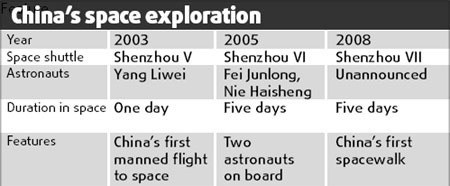
|
CHINA> National
 |
|
Optimal conditions set for spacewalk
(China Daily)
Updated: 2008-09-11 07:31 Bringing forward the launch date of China's third manned spacecraft by one month will maximize conditions for the country's highly anticipated inaugural spacewalk, experts have said. The Shenzhou VII spacecraft was first scheduled for take off from the Jiuquan Satellite Launch Center in Gansu province at the end of October. The spacecraft was later rescheduled for take off between Sept 25 and 30. Compared with the initial launching window in October, the position of the sun during the new period would enable astronauts to walk out of the space module in sunlight and avoid returning in "total darkness", the Beijing Evening News recently quoted an expert as saying.
The exact launch date at the end of this month will be decided by the weather conditions at the launch center, said Jiao Weixin, professor with the School of Earth and Space Science at Peking University. The launch could be postponed because of strong gales that could cause the rocket to veer off from its set course, he said. The best climate for launching the manned spacecraft include zero rainfall, a ground wind speed of less than 8 m per second, a minimum horizontal visibility of 20 km, and no lightning in nine hours before and after the launch, Jiao said. Drizzles and the temperature will usually pose no hindrance to the launch, he added.
The sandstorm had started to wane on Monday and moved to Lanzhou in the south, posing no threat to the launch, meteorologists were quoted by the Beijing News as saying. Earlier reports had said that the Shenzhou VII spacecraft will be launched on a Long March 2F rocket. On its return, the spacecraft will reportedly land within Wulanchabu, a city in the Inner Mongolia autonomous region. So far, engineers have installed the propellant in the spacecraft, a spokesman of the mission said earlier this week. The much-awaited mission is the second stage of the country's three-staged manned space program, which seeks to launch a manned spacecraft, set up a space laboratory, and build a space station before 2020. China became the third country to send a person into space on its own in 2003. In 2005, the country sent two more astronauts on a five-day flight on Shenzhou VI. On Shenzhou VII, there will be three astronauts, and one of them is expected to conduct a spacewalk. The astronauts will use a Chinese-designed and Chinese-made airlock module for extra vehicular activity - work done by an astronaut away from the Earth and outside of a spacecraft. The spacesuit is reportedly designed for such missions of up to seven hours. 
|
|||||